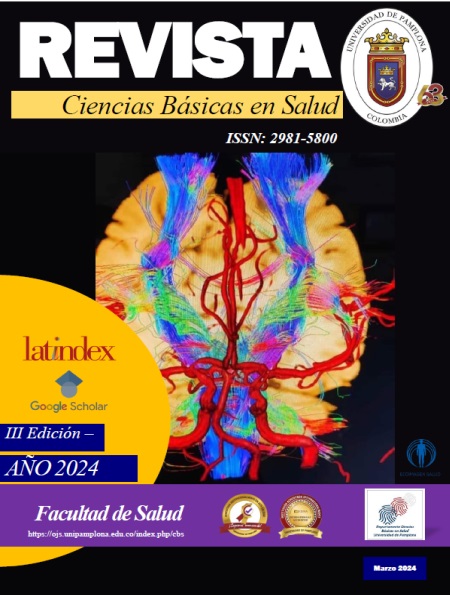Relación entre hiperacusia, tinnitus y los trastornos emocionales: una revisión sistemática
DOI:
https://doi.org/10.24054/cbs.v2i1.2775Palabras clave:
Tinnitus, hiperacusia, depresión, estrés y ansiedadResumen
Objetivo: determinar la relación entre hiperacusia, tinnitus y los trastornos emocionales, dado que, aunque las molestias auditivas por excesiva sensibilidad al ruido o estímulos sonoros y el tinnitus son comunes, disminuyen la calidad de vida del ser humano en sus diferentes facetas de vida. Materiales y métodos: Teniendo en cuenta el objetivo planteado, se realiza un planteamiento de la investigación descriptivo cualitativo, a través de una revisión sistemática orientada por la guía metodológica PRISMA, con la herramienta PICO, adaptada a la herramienta PIO. Resultados: Se tomaron 50 artículos de los cuales 18 hacían parte de estudios experimentales en humanos, en su mayoría de la fecha de 1994, 1995, 2002, 2003, en países europeos, debido a la escasa investigación acerca del tema en Latinoamérica. Discusión: La hiperacusia, el tinnitus si tienen una relación existente, por su conexión con estructuras neuronales compartidas y por los neurotransmisores en común para la regulación de las emociones y la hiperacusia y tinnitus, de acuerdo con la revisión de la literatura, se evidencia la relación existente entre la hiperacusia, tinnitus y los trastornos emocionales.
Descargas
Referencias
Aguirre, J. C. M., & Jaramillo, G. L. El papel de la descripción en la investigación cualitativa [The role of description in qualitative research]. Recuperado de www.moebio.uchile.cl/53/aguirre.html
Ariizumi, Y., Hatanaka, A., & Kitamura, K. (2010). Clinical prognostic factors for tinnitus retraining therapy with a sound generator in tinnitus patients. J Med Dent Sci, 57. https://pubmed.ncbi.nlm.nih.gov/20437765/
Baguley, D. M. (2003). Hyperacusis. Acta Otorrinolaringologica, 96. 10.1177/014107680309601203
Baguley, D., McFerran, D., & Hall, D. (2013). Tinnitus. En: The Lancet, 1600-1607.
Carlos Calvo, & Maggio De Maggi, P. Salud y Ciencia.
Curet, C. (2016). Tinnitus-evaluación y manejo [Tinnitus assessment and management]. http://dx.doi.org/10.1016/j.rmclc.2016.11.017
Domínguez, S., & Boccio, D. C. M. Hiperacusia en unidad de acufenos.
Herráiz, C., Plaza, G., & Aparicio, J. M. (2006). Mechanisms and management of hyperacusis (decreased sound tolerance). Acta Otorrinolaringologica Espanola, 57, 373-377. https://doi.org/10.1016/s0001-6519(06)78731-3
Investigación A. D. E., Morales Villa el Roble, B. O., Danilo pasaje, Morales B. O., Sepúlveda Sch, T., & Jury, C. S. (sin fecha). Characterization of patients with tinnitus and audiometric findings.
Juris, L., Andersson, G., Larsen, H. C., & Ekselius, L. (2013). Psychiatric comorbidity and personality traits in patients with hyperacusis. International Journal of Audiology, 52(4), 230-235.
Karamzina, L. A. (2021). Acoustic reflex inversion: biophysical reality. The European Journal of Biomedical and Life Sciences, (1-2), 38-42.
Landa-Ramírez, E., & de Arredondo-Pantaleón, A. J. (2014). Herramienta pico para la formulación y búsqueda de preguntas clínicamente relevantes en la psicooncología basada en la evidencia [PICO tool for the formulation and search of clinically relevant questions in evidence-based psycho-oncology]. Psicooncologia (Pozuelo de Alarcon), 11(2-3), 259-270.
Leira Permuy, M. S. (25 de junio de 2023). Manual-de-bases-biológicas-del-comportamiento-humano (1) [Manual of biological bases of human behavior] [Mensaje en un blog]. Disponible en: www.universidadur.edu.uy/bibliotecas/dpto_publicaciones.htminfoed@edic.edu.uy
Liberati, A., Altman, D. G., Tetzlaff, J., Mulrow, C., Gotzsche, P. C., Ioannidis, J. P. A., et al. (2009). The PRISMA statement for reporting systematic reviews and meta-analyses of studies that evaluate health care interventions: Explanation and elaboration. PLoS Medicine, 6.
López Ibor (2007). Ansiedad y depresión, reacciones emocionales frente a la enfermedad.
Marriage, J., & Barnes, N. M. (1995). Is central hyperacusis a symptom of 5-hydroxytryptamine (5-HT) dysfunction? The Journal of Laryngology and Otology, 109.
Moher, D., Liberati, A., Tetzlaff, J., Altman, D. G., Antes, G., et al. (2009). Preferred reporting items for systematic reviews and meta-analyses: The PRISMA statement. PLoS Medicine, 6.
Nelson, J. J., & Chen, K. The relationship of tinnitus, hyperacusis, and hearing loss. https://doi.org/10.1177/01455613040830071
Oyarzún D., P., Neustadt, N., Morris N., A. M., & Gómez M., G. (2022). Relación entre hiperacusia y desorden del procesamiento auditivo central: Una revisión de la literatura. Revista Chilena de Fonoaudiología. http://dx.doi.org/10.4067/s0718-48162022000100101
Oyarzún D., P., Neustadt, N., Morris, A. M. N., & Gómez M., G. (2022). Relación entre hiperacusia y desorden del procesamiento auditivo central: Una revisión de la literatura. Revista Chilena de Fonoaudiología. http://dx.doi.org/10.4067/s0718-48162022000100101
Page, M. J., McKenzie, J. E., Bossuyt, P. M., Boutron, I., Hoffmann, T. C., Mulrow, C. D., et al. (2021). The PRISMA 2020 statement: An updated guideline for reporting systematic reviews. The BMJ, 372.
Risso-Migues, A. (2002). Neuroplasticity and Education. Eye movements. Disponible en: https://www.researchgate.net/publication/275823971
Roitman, D. (2018). Online research on tinnitus and hyperacusis via our website. Loquens, 5(2). https://doi.org/10.3989/loquens.2018.052
S, M., & Cortés, C. (sin fecha). ARETÉ ARETÉ Fonoaudiología Revista. Revisión de la relación entre estrés y tinnitus. Recuperado de https://arete.ibero.edu.co/article/view/6382.
Santos Goncalves, M., & Tochetto, T. M. (sin fecha). Hiperacusia: un abordaje teórico. [Hyperacusis: theoretical approach]. Recuperado de http://www.redalyc.org/articulo.oa?id=169320502012
Santos Goncalves, M., & Tochetto, T. M. (sin fecha). Hiperacusia: un abordaje teórico. Hyperacusis: theoretical approach. http://www.redalyc.org/articulo.oa?id=169320502012
Sanz, J. (1993). Distinguiendo ansiedad y depresión: Revisión de la hipótesis de la especificidad de contenido de Beck. Vol. 9.
Sdg, S. (1994). Tinnitus and suicide. Clinical Otolaryngology, 19.
Urnau, D., & Tochetto, T. M. (s.f.). Occurrence and suppression effect of Otoacoustic Emissions in normal hearing adults with tinnitus and hyperacusis [Ocurrencia y efecto de supresión de emisiones otoacústicas en adultos normo-oyentes con tinnitus e hiperacusia]. Recuperado de http://www.bjorl.org/
Wallén, M. B., Hasson, D., Theorell, T., & Canlon, B. (2012). The correlation between the hyperacusis questionnaire and uncomfortable loudness levels is dependent on emotional exhaustion. International Journal of Audiology, 51(10), 722-729.
Zeng, F. G. (2013). An active loudness model suggesting tinnitus as increased central noise and hyperacusis as increased nonlinear gain. Hearing Research, 295, 172-179.
Descargas
Publicado
Número
Sección
Licencia
Derechos de autor 2024 Revista Ciencias Básicas en Salud

Esta obra está bajo una licencia internacional Creative Commons Atribución-NoComercial 4.0.







